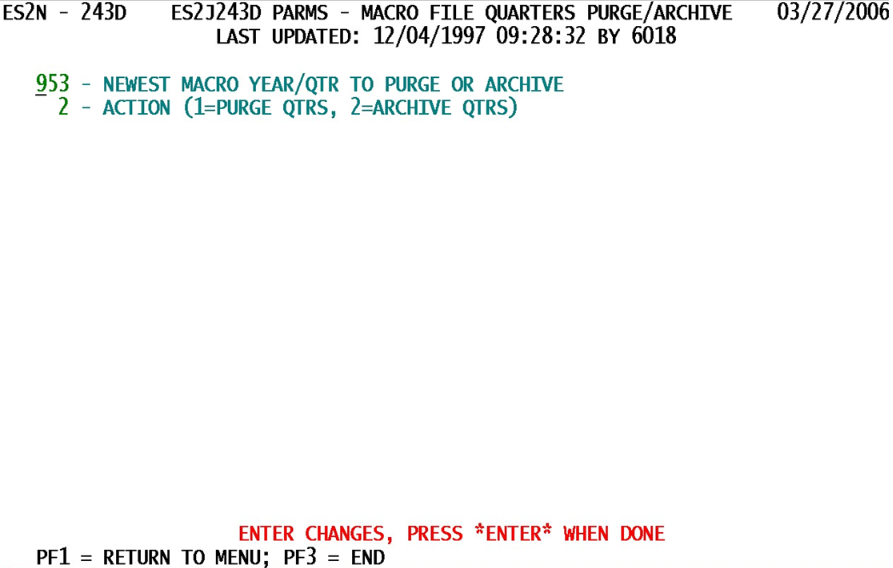14 job 243d macro archival purging processes
Job 243D - Macro Archival and Purging Processes
At one time (before the MicMac process came to fruition in 1997), the Macro File was limited in its storage capacity. Now, however, macro data can be stored for an indefinite expanse of quarters. As a result, Job 243D has been essentially gathering dust for the past decade. It is available, however, to remove any quarters that are no longer needed for analysis. These quarters can either be simply wiped off the file without a trace, or they can be forwarded to the Macro Archive File, a file that parallels the Micro Archive File’s function. It would provide such a parallel, that is, if it could be found. To date, no EXPO State is known to have ever produced a Macro Archive File. Job 243D stands at the ready, even though the parameters (just as in the sample screen) have become quite old. Here are the parameters:
1. Newest Macro Yr/Qtr to Purge or Archive - This 3-digit year/quarter field (in the standard ‘yyq’ format) is not limited by the absence of century digits. Anything with a year larger than ‘35’ will be interpreted as being in the 20th century. This is the most recent quarter to remove from the Macro File (whether or not the data are archived). However, this implies that any quarters earlier than this quarter will also be purged/ archived from the file as well. If you want to keep a minimum amount of macro data on hand (8 or 9 quarters), the rest of the data can be removed by setting this para-meter to two years before the prior quarter (e.g., if current quarter is 06/1, then a setting of ‘034’ would keep the macro data trimmed to a minimal level).
Warning: Since there are only eight quarters of micro data, it is very difficult—if not impossible—to rebuild these quarters once they have been purged. The only means of recovery is to restore the Macro File from the back-up file (which is kept for only five generations); this explains why this job has been employed so rarely.
2. Action (1=Purge Qtrs, 2=Archive Qtrs) - This switch is equivalent to a yes/no option regarding whether data should be archived during the purge process. The values are:
- a. ‘1’ (“Purge Only”) - Delete the specified quarter, along with any historical data preceding that quarter, from the Macro File, but do not archive it (i.e., there will be no need for this historical data at any point in the future). This would be along the lines of the “living dangerously” group.
- b. ‘2’ (“Purge and Archive”) - Populate the Macro Archive File (or add thereto, if this file has been created in the past), loading all of the archaic macro records to the archival records before removing them from the production file. This leaves the data still accessible for reports, but disallows their use in on-line screens (since the Macro Archive File is not an indexed file, a fundamental requirement for CICS screen usage).
The 243D job, if it is used at all, would only be employed when file space becomes a concern. Generally, this would be near the end of the quarterly production cycle, after the integrated edits have been initiated.
Related Links
